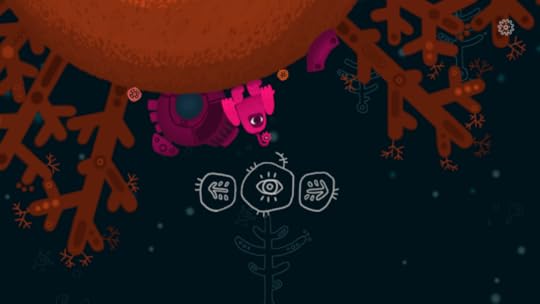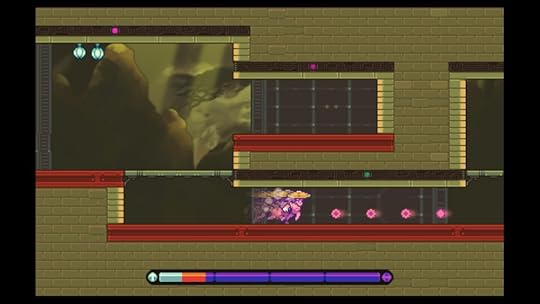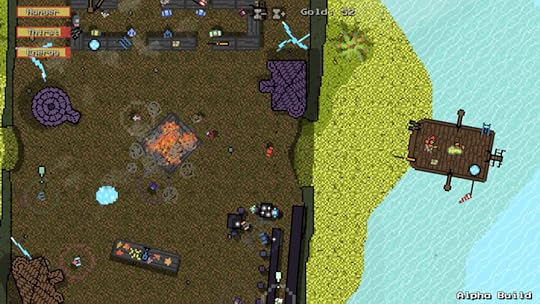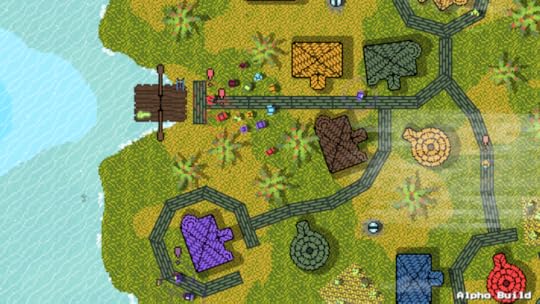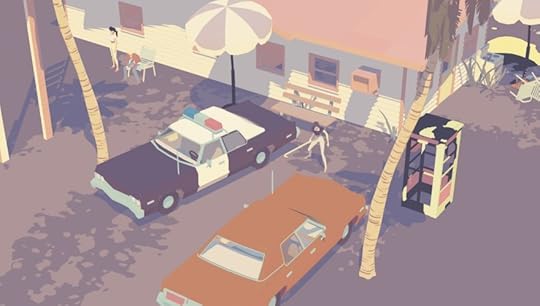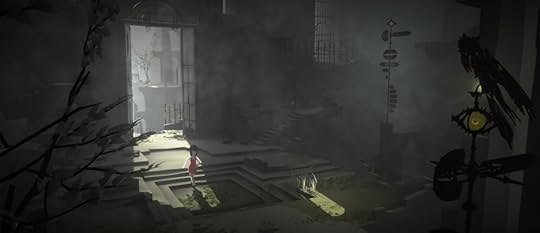Kill Screen Magazine's Blog, page 26
November 29, 2016
5 Tips for Finding Success as an Indie Game Developer
This article is part of a collaboration with iQ by Intel .
While being an indie designer remains a gamble, experts prove the right tools and mindset can make a difference.
The car-soccer game Rocket League’s beta version launched in April 2015 with low expectations. Rocket League was a seemingly ill-fated sequel to a title that developer Psyonix released seven years earlier — the unruly titled, Supersonic Acrobatic Rocket-Powered Battle-Cars (2008), which had limited success. To prepare for Rocket League, Psyonix had its servers ready to handle up to 10,000 online players simultaneously. But when 180,000 joined the game, their servers computers came crashing down, bringing gameplay to a halt.
“In retrospect, we could have better prepared for the influx of players that melted our servers,” admitted Corey Davis, Psyonix’s design director. Learning from such failures, Davis said, is key. Rocket League became an overnight indie success. It raked in over $110 million in sales with a team of no more than twenty people. To reach success, the Psyonix team overcame many obstacles facing indie designers eager to hit the big time. Independent game studios are born out of big dreams. But traversing the Wild West of game design also means navigating the technical world of business, from revenue streams to marketing.
Independent game studios are born out of big dreams
While some grants like Intel’s Level Up Game Developer Contest can help with obstacles like quality assurance testing, indies remain largely on their own in terms of making their games profitable. Here are a few tips on the right tools and mentality Psyonix, Vlambeer, and other independent developers have learned along the way.
TIP 1: Follow the “minimum sustainability model” to budget for success – and failure
Psyonix used a business model that gave its team “multiple chances at success.” In other words: plan for failure. Making a game is risky and, to keep the lights on, indies need to generate stable revenue. Daniel Cook of Spry Fox termed it the “minimum sustainability model,” which suggests that studios sort all their projects into a revenue stream based on the success rate of previous projects, the size of each prototype, and their variability in potential profits.
Teams like Acid Nerve from critical hit Titan Souls (2015) and Le Cartel of the beloved Mother Russia Bleeds suggested Google Drive and Slack for maintaining clear communication on these fronts. The process of figuring out what works for a specific studio’s talents is a long game, but worthwhile, according to Davis. It took Psyonix ten years of contract work with big publishers before they found the “moderate success needed to reach the point we’re at now,” Davis said. The sustainable income gave them the freedom to work on passion projects, one of which became Rocket League.
TIP 2: Use automated systems to communicate with the press
Small teams are always pressed for time, with each member wearing multiple hats. That’s why Rami Ismail, one-half of indie developer Vlambeer, is dedicated to creating automated tech solutions for one of his biggest headaches: dealing with press. Presskit() is now widely accepted as the go-to template for indies. It’s free and centralizes the essential information about their game onto a single web page. Whether it’s giving streamers the go-ahead to monetize footage, supplying hi-res images, or providing Google Analytics integration, Presskit()’s utility is proven by its ubiquity.
The service’s tagline, “spend time making games, not press,” adequately summarizes its major contribution to the developer community. After transforming the way indies did PR, Ismail moved on to automating review distribution with Distribute(). Working hand-in-hand with Presskit(), it provides other PR solutions like sending review codes and prioritizing press reach outs. “The biggest challenge for indies is not knowing what they don’t know,” said Ismail. “Presskit() and Distribute() are intentionally built to train people to think in specific ways.”
That is, these tools are designed around questions that are supposed to help creatives like indie designers see their game like a marketer would. Most importantly, it’s easy, and lets developers quickly get back to doing what they do best: making games.
Indies are doomed to digital obscurity if people don’t click and buy their game shortly after launch
Tip 3: Be smart when launching
Working during the height of the indie game movement is both a blessing and a curse. While the scene is hungry for titles, it’s harder than ever to stand out in the endless sea of new releases on Steam. Intel’s Product Marketing Engineer, Mitchell Lum, explained that due to the algorithms used by distributors like Steam, indies are doomed to digital obscurity if people don’t click and buy their game shortly after launch. “Within a short window of time, maybe an hour or so, you’ve either fallen into the abyss or are standing on a pile of money,” Lum said.
“Indie devs hit a real wall in finding visibility on any marketplace,” agreed Luke Burtis of TinyBuild, a publishing house for and by indies. Psyonix used a simple trick to combat the indie market’s oversaturation: it launched in the summer, during the biggest lull in game releases.
TIP 4: Try to build an audience before launch, not after.
Another tactic is launching with an already established audience. While some indies have the resources for a publisher with marketing capabilities, others are getting creative in how they get the word out. Psyonix didn’t spend a single dime on traditional marketing. Instead, they attribute Rocket League’s success to its naturally viral gameplay. During its beta, the fun and ridiculous antics of car-soccer translated perfectly into the GIF format. Once Reddit got a hold of some, word spread like wildfire.
The multiplayer arena game Streamline takes a similar approach by embedding shareability into its design. Created by Proletariat, it’s specifically geared for Twitch broadcasters, giving them the opportunity to actually play the game with fans on their stream. Viewers vote to determine the game’s rules, special abilities, maps, and characters. “Having that shared experience of social video makes the game practically distribute itself,” explained CEO Seth Savik.
TIP 5: Invest in online gameplay
While an online component adds the cost of server computer performance, both Psyonix and Proletariat agree that the benefits far outweigh the cost. They recommend Google App Engine and Amazon Web Services, respectively, for scaling up. Tapping into cloud services for needed computer performance can help indies handle an unexpected surge simultaneous online players.
Savik says it’s hard to plan for, but rigorous scale-testing is the best plan for success. Davis insisted that, for input and latency-sensitive games like Rocket League, managing a dedicated server internally is a “must” to ensure quality. As these indie stars admit, the success of any game is a unique journey rather than a repeatable process. “There’s a lot of luck involved,” said Davis. “There’s no guarantee that your first or second game will be a hit. Your goal should be to make quality products and find the right audience.”
The post 5 Tips for Finding Success as an Indie Game Developer appeared first on Kill Screen.
November 28, 2016
Puppet show based on Siberian fairy tales becomes a videogame
One Eyed Kutkh is to be a videogame that imagines how the fairy tales of eastern Siberia would turn out if they were about space travel. It follows the titular traveler from outer space—a one-eyed alien, basically—as they try to make their way home, but end up lost on Earth. According to the game’s description, to return to his journey, the traveler needs “to get to ninth heaven, deceive the Sun and the Moon and steal their space-boats.” This is something he’ll manage to do with the help of the indigenous people of the area.
The story is a delicate weaving of traditional folk tales and original fiction based on our current knowledge of the universe by the Saint Petersburg-based studio Baba Yaga Games. They chose to work with the old tales that originate from eastern Siberia due to the studio’s artist and co-founder, Lyuba Nurmukhambetova, having spent her childhood in Yakutia and therefore having an understanding of the culture. “She has a lot of books with fairy tales, myths, about shamanism, about folklore and rituals, which we used in our work,” the studio’s other co-founder, Asya Yurina, told me.
“the poetry and warmth that seems cold and distant to most of us”
While coming up with the world for their game, what the studio decided was that it would be based on the World Tree from the indigenous people’s culture, but it “would be possible to travel between the upper, middle and lower worlds by the rocket. And people could move from one planet to another.” And so while the game may serve as an introduction to the fairy tales it is based on, the changes that have been afforded mean that Baba Yaga don’t intend for it to be representative of that culture, or to educate about it in any way. “We just hope that our players will try to look at the world through the eyes of the men of this culture, learn to see the poetry and warmth that seems cold and distant to most of us,” Yurina said.
This is something that Baba Yaga thinks videogames can achieve better than many other mediums. The two co-founders have a background in puppetry and theater, and actually, One Eyed Kutkh was planned to be a puppet show, but then they saw the potential of turning into an adventure game. According to Yurina, the videogame format gives them more freedom and possibilities when implementing their ideas—for starters, they don’t need to think about where they’re going to hide a puppet’s strings and the person operating them.
“Theater stage is very limited space, and it’s a challenge for the artist, but now we would like to simply do everything that [comes] to mind, without thinking about the size of the stage and the presence of the required lighting equipment,” Yurina said. “Also, the format of the videogame allows us to communicate directly with our audience, making it a part of the story. We believe that the main advantage of videogames as an art form over all others is a direct dialogue with the player.”
One Eyed Kutkh isn’t Baba Yaga’s first videogame. That title belongs to the children’s educational app It’s Spring Again, which was released last year, and uses the same bold, sketchy-line art style. One Eyed Kutkh is still in development and should be coming to Windows, Mac, Linux, iOS, and Android soon. An online demo is available on its website.
You can find out more about One Eyed Kutkh and play its online demo on its website. You can also vote for it on Steam Greenlight.
The post Puppet show based on Siberian fairy tales becomes a videogame appeared first on Kill Screen.
Goodnight Traffic City seeks a truer reflection of living with health issues
The message of the “Everyday” exhibition currently on display at La Mama Galleria, New York until December 10th is that “AIDS is EVERYDAY.” The art and ephemera produced for the gallery is all a reminder of this—that until there is a cure, and the infrastructure exists to distribute it to those who need it, there are people who must live with HIV and AIDS as part of their daily life.
Babycastles and Visual AIDS teamed up to produce the exhibition, each organization collecting their favorite artists and partnering them up to produce new, exclusive artworks. One of those pairings saw game maker and digital artist Loren Schmidt team up with HIV-born multidisciplinary artist Kia Labeija. Together, they created Goodnight Traffic City, which they describe as “a game about gardening and building a complex relationship with space.”
a “conversational approach to mechanics”
Meant to be played in “serial multiplayer” (as in: multiple players, who return to the game), the idea is for players to move freely across the rambling world of Goodnight Traffic City, finding seeds and various other items. “Players who choose to can cultivate gardens, chart the world, find and create transit networks,” Schmidt told me, adding “all or none of these.” By that she means that players aren’t forced towards doing anything in particular—there are no goals or even any fixed ideas of progression. It’s meant to be uncontrolled and exploratory.
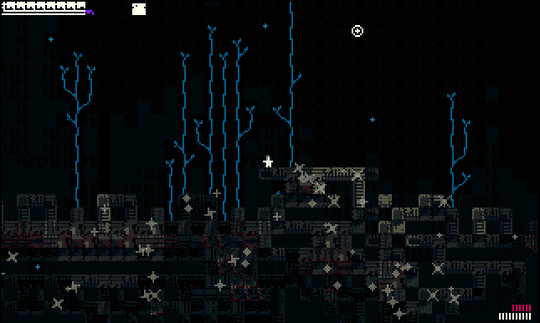
But that’s not to say there isn’t any kind of push and pull in the game at all. Schmidt referred to what she calls a “conversational approach to mechanics” that encourages an interaction with the game’s world. “Traditionally, one is faced with skill tests and tasks, and action is incentivized by threat and reward in various currencies,” Schmidt said. “That wouldn’t have worked well for us here. We were trying to create a complex set of shades of grey, emotionally, so the moral simplicity of that kind of approach wouldn’t have been a good fit.”
It is exploration of the game’s 2D spaces and the flow of available resources that sit at the heart of Goodnight Traffic City. Each area in its world has its own distinct textures and offers up different types and numbers of seeds and items. But there is not necessarily any predictability to this. “At times it is beautiful, at times ugly, sometimes it hinders us and other times it is unexpectedly helpful,” Schmidt said. Here, she isn’t just describing the game’s world, but also what the relationship you build with it represents—the complexities of living with health issues.
While she didn’t confirm as much to me, the assumption is that the allegory is informed by Labeija’s own experiences living with HIV. The point of Goodnight Traffic City is to deviate from the usual narrative of living with illness and to introduce intricacies that are usually left out. This is typical of Labeija’s previous work in portraiture and performance. The description of Labeija’s work by Visual AIDS attests to this: “she stages digital portraits as theatrical and cinematic re-imaginings of non fictional events to spark conversation, complicating the way we view her subjects and the spaces in order to occupy.”
You can play Goodnight Traffic City until December 8th at the Everyday exhibition. A version of the game will be released to wider availability.

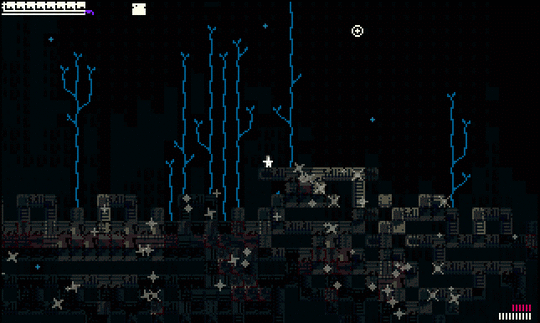
The post Goodnight Traffic City seeks a truer reflection of living with health issues appeared first on Kill Screen.
New platformer wants you to know the environment is screwed
Sign up to receive each week’s Playlist e-mail here!
Also check out our full, interactive Playlist section.
Even the Ocean (Windows, Mac)
BY ANALGESIC PRODUCTIONS
Even the Ocean is a warning. It’s a game that wants to raise awareness of the human impact on the environment and for its players to spread its message. Its fictional world needs to be balanced by light and dark energies, and due to an imbalance brought about by power-hungry politicians, that world is accelerating towards its end. You play a power plant engineer who is tasked with trying to restore the balance and hopefully saving the world. The result is a platformer that lets you skip its challenges and focus on the story if wish, knowing that its message is important, and wanting to reach as many people as possible. The timing of the game’s release couldn’t be better, coming just days after climate scientists declared the polar ice caps were in a state of “emergency,” as well as the results of the American presidential election. Even the Ocean might help you gather your thoughts and priorities in a confusing time.
Perfect for: Naturists, engineers, politicians
Playtime: 4 hours
The post New platformer wants you to know the environment is screwed appeared first on Kill Screen.
November 23, 2016
Fleeing the conflicts in Turkey and the personal game about it
“Making Soul Searching has been a way for me to make sense of what’s happening,” Turkish game maker Talha Kaya told me. He’s talking about his latest videogame, his biggest to date, which explores the theme of leaving your homeland and parents behind—a journey that’s inspired by the real-life drama of Kaya’s personal life.
As Kaya described it, the situation in Turkey has been getting more and more depressing over the past 10 years. He told me that the nation is fighting with itself and, not so dissimilar to the perceived future of America, has a government that empowers the bad side of religion and nationalism. “Turkey is actively participating in more than one war right now. There has been huge terrorist bombings by multiple terrorist groups including ISIS,” Kaya said. “So, living in Turkey is depressing. I’m from a generation that were lucky enough to get good education in Turkey, and see what Turkey could have been but hasn’t, so wanted to leave the country.”
Six months ago, Kaya, his brother, and their wives were able to leave Turkey and move to Barcelona due to getting jobs there. They plan to stay there for at least another three years as, after doing so, they are able to pay the Turkish government some money to avoid doing the mandatory military service for Turkish men. “We want to avoid military service mostly because it’s a huge waste of time, but also because it’s a very depressing place for creative people,” Kaya told me. “And in three to five years, if we surpass our military service, we can move back to Turkey whenever we want and see our parents as we please.”
“Don’t you feel vulnerable when that whale jumps up?”
The main character in Soul Searching, the game Kaya has been making for the past three years, is on a similar plight. They’ve left their homeland and are sailing across the ocean, fighting to survive against dangerous creatures and hunger, but also dealing with isolation, the search for meaning and direction, as well as depression and suicidal thoughts. All of this is very personal to Kaya who has dealt with and explored these kinds of heavy themes in his previous, smaller games. “There’s a lot of ‘me’ in the game,” he said, “the player is a guest visiting my mental space.”
But Kaya also admits that he’s taken a lot of inspiration from Ursula Le Guin’s Earthsea series and the 2012 survival drama Life of Pi. He actually took the mythology directly from the Earthsea series and used it for his game, including the relationships between humans and dragons, the use of magic, and the philosophy of trying to be a humble human being in the world. The Life of Pi influence on Kaya’s game is more specific, it being the scene with the whale in the movie—”Don’t you feel vulnerable when that whale jumps up? I think it’s amazing,” Kaya said. The imagery of a person stuck on a boat in the middle of an ocean is recreated in Soul Searching to draw attention to the smallness of our individual lives.
Kaya also takes the unreliable narrator in Life of Pi who, at the movie’s end, makes you question whether the events it depicts were real or made up. This is something that Kaya calls a “narrative trick,” of which he has used many in game as a way to make the player question the validity of the human view of the world. “As humans our perspective is very limited. Our eyesight misses a lot of things, and our brain is programmed to see patterns where there is none,” Kaya said. “I think things like religion and other philosophies that help us make sense of this world is a consequence of this limitation we have.”
Throughout Soul Searching, the player will experience the “instant changing of scenes” such as in Thirty Flights of Loving (2012)—an unexpected cut from one place to another—and the subversion of reality as seen in Mulholland Drive (2001), among many other techniques meant to build up a distrust of the narrative. “One of the themes in Soul Searching is our relationship with media, and our immersion, which is easier to talk about when you free yourself from a dependable set narrative,” Kaya said.
Soul Searching is currently up on Steam Greenlight. It is expected to release for PC in 2017. Find out more about Talha Kaya on his website.
The post Fleeing the conflicts in Turkey and the personal game about it appeared first on Kill Screen.
Dead Static Drive to be a road-trip horror in vintage Americana style
Watching the R-rated horror classic The Evil Dead (1981) when you’re about seven years old leaves a lasting impression. Mike Blackney can vouch for this. He can trace his fascination with a distinctly American strain of horror “set in rural areas or suburbs” back to that seminal viewing. It carried him through the works of authors such as David Morrell, Joe R. Lansdale, and T.E.D. Klein, and now it’s what’s shaping his road-trip horror game Dead Static Drive.
Due to Blackney’s interest in “horror in mundane settings,” the main mission in Dead Static Drive is to go on a “road trip to reconnect with family that you’ve become estranged from.” You travel between towns where, to progress, you only need to refuel and sleep, or at least have some coffee. It’s deliberately dull so as to encourage players to get “distracted by saving the world” along the way. In each town, players will be able to roam freely and find many optional activities to pursue—but these aren’t your typical by-the-number side quests, they’re the meat of the game.
“Grand Theft Auto … but more like Grand Theft Cthulhu”
This design not only fits Blackney’s commitment to his horror fiction interests, though, as it’s also a response to other sandbox games. “I’ve found that when I play sandbox games like Oblivion (2006), I’m given at the start an epic quest to save the world but instead of closing all these gates and saving the world, I end up stockpiling cheese and fixing up NPCs marriages and doing anything that I find interesting at the time,” Blackney said. “I sort of want to invert that.” The fact that you are often asked to urgently save the world in these types of games but are able to spend several hours doing much less important tasks has become something of an internet joke. Dead Static Drive‘s approach is more sensible in that regard.
But “sensible” isn’t necessarily a word that should be applied to Dead Static Drive in any other context. Take Blackney’s vision of the game, which he once described to a friend as: “It’d be like Grand Theft Auto … but more like Grand Theft Cthulhu.” Since then, Blackney’s been trying to make a game that satisfies that tagline; one that lets you steal cars and cause havoc for no real reason, a game that has witchcraft, ghosts, and “incomprehensible entities who live below time, exhaustion, and paranoia.” He’s been able to indulge in the cosmic horror that has gripped his attention most of his life.
In fact, Dead Static Drive could probably serve as a manual to understanding many of Blackney’s passions. Aside from the horror, the game’s visual style is a direct throwback to the vintage poster art that he loves so much. From the very start, he’s aimed to make the game look like a “the retro advertisements on travel atlases and old tourism posters, mixed in with that modern vector art like Mondo posters.” It’s a patchwork of subtle gradients, hard lighting, and soft-edged colors. Blackney also takes from anime feature films such as Akira (1988) when working on special effects, plus he has put together a “driving horror bible” of visual influences, they just don’t stop coming.
“exactly what we need to help make videogames seem grounded and real”
“William Eggleston and Stephen Shore have some incredible photography that helps me with the really mundane and retro Americana look I’m going for—the old, everyday that we walk past all the time but that doesn’t register,” Blackney added. “Lots of photographers who take the time to photograph everything end up capturing such richness and boredom that is exactly what we need to help make videogames seem grounded and real.”
Currently, Blackney is far from finishing Dead Static Drive but has plans to have it playable by the end of 2017. He’s keen to not put a date on when it might be out as there’s still plenty to do and he’s the only one working on it. Plus, he’s still learning a lot of the processes that go into making Dead Static Drive and refining others. “Just this week I added a new type of lighting that helps make car headlights look more comic by removing the double-bright section in the middle where the two headlights overlap,” Blackney told me, “and while I was doing it, I made a few bugs that I thought added to the comic look.”
He did say that he would love to get the game on consoles, especially as he’s making it with a gamepad in mind, and has been playing his PlayStation Vita a lot during the production, encouraging him to make some decisions with portability in mind. “I’d love for anyone who wants to play it to be able to play it, and for now I’m targeting PC, PS4, and Xbox One,” Blackney said. “I’d also love to see the game on a Switch because it’s the kind of game you really can play in short installments, on the go.”
You can sign up for updates on Dead Static Drive on its website. Keep an eye on its Twitter account for other updates.
The post Dead Static Drive to be a road-trip horror in vintage Americana style appeared first on Kill Screen.
November 22, 2016
MARE’s new teaser shows off its subtle environmental language
A cold wind blows around the stony ramparts of an old, crumbling fort. A young girl in a red dress lies on her belly, seemingly asleep in the grass, black hair fidgeting with the breeze. The electrical wires hanging between tall mechanical pylons also shake to the chorus of the grey gale. The new teaser for MARE, an upcoming “exploratory and sensory VR adventure” by Visiontrick Media, starts with several slow shots of its environments and characters. According to Rui Guerreiro the point is to introduce MARE as a game of subtle contrasts.
It’s a game in which you help the little girl journey through a mythical world that is “lost in time and space [and] filled with untangled mysteries,” with no clear goal other than to keep moving forward. To do this, you need to help her control a mechanical bird that she feels attached to for unknown reasons. You have to steer it between the electrical pylons scattered through the land. This idea came directly out of the game’s format as a VR game that is controlled by the player’s gaze—specifically, where they tilt and turn their head towards.
Visiontrick wants to generate surprise
“We tried to utilize certain aspects that worked and felt very natural to VR, for example looking around, gazing and and exploring the environments with one’s sight,” Guerreiro said. “And from that point it became pretty clear that moving between certain points or beacons within the environment would be a good way to structure and move around in the game.” This design means that the game needs to somehow direct the player’s gaze to each beacon or area of interest, otherwise they’ll get lost. But Visiontrick also wants MARE to be understated—”for the game design and art to be one and the same,” as Guerreiro put it to me.
It would be too easy to have glaring contrasts in colors and light to attract the player’s attention, or to have waypoints to more directly guide them. Visiontrick wants to generate surprise and give the player a sense that they have some agency in their exploration rather than following obvious signposting. And so the key to solving all of these issues is building a subtle language into the game’s environments. This is what this new teaser trailer is all about: Guerreiro wants you to see the “contrasts between the stillness of the ruins and, for example, the movement of a lonely tree that sways with the wind or the childlike playfulness of the girl.”
Fortunately, Visiontrick has had a lot of practice when it comes to creating geography that is in conversation with the player due to the other game it’s making at the same time. The first episode of Pavilion was released earlier this year; a game that tasks the player with manipulating bells, torches, and other embellishments in the walls of its surreal labyrinth in order to guide a man through it. It seems likely that many of the lessons Visiontrick may have learned while making Pavilion could be transferred to MARE.
Given that Visiontrick is developing both of these games (MARE and the other episodes of Pavilion) it’s understandable that they don’t have a release date for either yet. Guerreiro did tell me that MARE is about 50 percent complete so far, though, and also confirmed that, for now, they’re only working on it for Oculus platforms. “At the moment it can only be played with one’s gaze and there’s no concrete plans for a non-gaze version,” he added.
Find out more about MARE on its website.
The post MARE’s new teaser shows off its subtle environmental language appeared first on Kill Screen.
Taking up the responsibility of making games for the visually impaired
Jarek Beksa first encountered the need for audio-based games when working for Orange—the telecommunications company—in Poland. He was doing a usability study with voice recognition and speech synthesis applications, during which, one of the blind testers said, “Nobody makes games for us.” It drew Beksa towards the potential of using this technology to make games for the 300 million visually impaired people around the world.
But it wasn’t until a few years later and after a move to New Zealand that Beksa would act upon his realization that day. He’s currently doing a PhD research project at Auckland University of Technology, part of which is making audio-based games—the idea being to experiment with effective ways to design and develop games for the visually impaired. For this project, Beksa put together a team of game makers from the university and launched Audio Game Hub.
“most of our assumptions were wrong”
The team started off as simply as they could by making an arcade game that they thought would only take a few days to finish. “But when we started testing it with real users we found out that most of our assumptions were wrong,” Beksa told me. This is the kind of feedback that Audio Game Hub would get frequently as, after making that first arcade game, they went on to make seven other small audio-based games. “We had to redesign and redevelop most games many times until they were ‘playable’ without the need to look at the screen.”
The intention of these eight games was to experiment with different types of input and interfaces. One challenges your memory, another is a slots machine, and yet another has you shooting arrows at a target. The latter is a good example of how the team tweaked an established format to make it playable through audio alone. It works by having a cursor move back-and-forth across the target with the audio swelling when it gets near the bullseye. There’s also a variation of this archery game in which the player hunts animals in a forest, having to move the cursor across the screen themselves to locate their prey with a series of clicks, which increase in frequency when they’re aiming at the animal as it runs around.
Making these games also enabled the Audio Game Hub to refine the processes and priorities when making games for the visually impaired. Beksa told me that, surprisingly, a lot of audio-based games don’t actually have good sound quality—they use speech synthesizers and poor sound effects. Audio Game Hub tackled this by recording its sounds in a studio, but also learned that there’s more to a good sound effect than its sonic quality, as figuring out how to communicate different types of actionable information to players through a sound effect is a fine art.
“There is a need and a responsibility to provide the visually impaired with richer gameplay”
Audio Game Hub released its pack of eight arcade games for free back in April 2016, for PC, iOS, and Android. To the team’s surprise, it has since accumulated over 35,000 downloads without any promotion or marketing. Along with plenty of positive user reviews, the team was also given the App of the Month Award by the Royal National Institute of Blind People, and was the winner of the Representation Award at the Play by Play International Games Festival. Another surprise was that sighted players were also attracted to and enjoyed the audio-based games due to them stimulating imagination, according to Beksa.
This is only the start for Audio Game Hub. Beksa and his team are the first to say that their eight arcade games are much more simple that most other digital games. “There is a need and a responsibility to provide the visually impaired with richer gameplay than what is currently available,” Beksa said. “And this is where we come in to continue this good deed and expand on our original project.”
This is why they plan on both expanding the arcade games pack with an additional five games as chosen by Kickstarter backers, but are also working on an audio-based RPG called The Whispering Tunnels. It will let players choose paths along a dangerous adventure, develop a character, interact with other characters with dialogue, and complete quests as they try to escape the traps and monsters of the eponymous tunnels.
The money raised from the Kickstarter will go towards hiring professional voice actors and purchasing sound effects and music for these new games. And to Audio Game Hub’s delight, the base funding goal has already been reached, with two weeks still to go to raise more money that will go towards sending the games out to foundations and developing more arcade games.
You can download the original Audio Game Hub pack through its website and support the team’s future work on Kickstarter.
The post Taking up the responsibility of making games for the visually impaired appeared first on Kill Screen.
Check out the animations on this upcoming ASCII adventure
Thanks to the events of 2016, a lot of us are starting to get used to the concept of living in a society filled with evil. Stone Story is way ahead of you. The game is set in “a dark and vile world,” populated with haunted trees, reanimated skeletons, giant snails, and antagonistic bats. The protagonist is on a quest to change it all.
carefully animating the game for over two years
Stone Story features four boss fights, six unique locations, and multiple cutscenes, all animated in plain text ASCII style, with characters and weapons built from recognizable keyboard symbols like hyphens, parentheses, and semicolons. Developer Standard Combo has been carefully animating the game for over two years now, and the lo-fi visual style is inspired by artwork from the 90s.
These retro visuals are combined with largely automated gameplay, where you equip the AI-controlled protagonist with gear and items of your choice before sending them out into a realm filled with evil to fight, loot, and explore without the player’s guidance. There’s also a crafting system that allows you to combine otherwise disposable items looted by the protagonist to create something useful. Maybe, if you play your cards right, you can use them to make the world a little less evil.
Stone Story doesn’t have a release date yet, but the developer plans for it to be published on Windows, Mac, Linux, iOS, and Android. Standard Combo is run by one man, Gabriel Santos, whose prior use of ASCII animation can be seen in his first game, Pyramid Builder.
Click here to visit Stone Story’s site and learn more.

The post Check out the animations on this upcoming ASCII adventure appeared first on Kill Screen.
Fake your way through the art world in Passpartout
If you’ve ever had a table at a convention, or had your work in a gallery, you’ve experienced the sharp sting of a stranger’s silent judgement. “How are you enjoying the show?” you ask as they walk by. They look down at your work and scowl, moving on wordlessly to buy some crappy fan art from the next table over. Your soul wilts. Now you can experience that virtually to, with Passpartout, a simulation of the French art world.
You play as a painter, struggling to strike a balance between authenticity and paying your bills (rent, wine, baguettes). You start by painting a self-portrait and putting it up in your gallery. Guests come in, either to rudely comment, or make a purchase—in my case it was a rude comment 90 percent of the time.
an emphasis on the performativity of the whole art scene
“Too overworked,” says a guest. So you go abstract and simple, four squares in bright colors. “I want something calmer than this,” says another guest, so you paint a bunch of squiggly blue lines in different shades, which they walk by without a glance. “My three year old puts more effort in than this,” says yet another guest. Then the canvas that you literally just threw a single red line on catches his eye. “Perfect for my man cave!” he exclaims, handing you some euros and walking away with the painting you were certain was the worst.
Of course, if you work hard, make enough art, and are better at painting with a mouse than I am, you could make it as a proper artist in this game. With diligence, you can do more than just make rent and buy baguettes, you can get bigger, fancier galleries to work in and house your art. So more people can come by and tell you something you don’t know about art.
Passpartout has an emphasis on the performativity of the whole art scene, opening the game with red curtains, and having the scene set with a cut away building, and cardboard props out front. The characters are all made to look like puppets, and their lines repeat each other in a way that feels purposeful. You may want to yell, “None of you know what you’re talking about! That’s a piece of bacon with a baseball cap! It’s not ‘exquisite!’” But that’s the point. They’re just pretending to know. But to play this game, you’ll have to play theirs.
Learn more about Passpartout here. You can get access to the alpha version on its website.
The post Fake your way through the art world in Passpartout appeared first on Kill Screen.
Kill Screen Magazine's Blog
- Kill Screen Magazine's profile
- 4 followers






